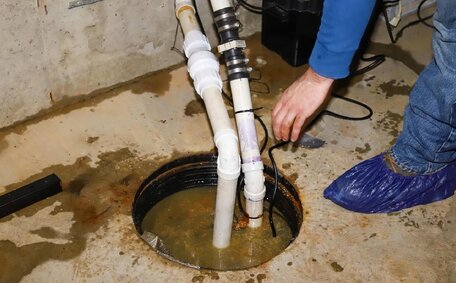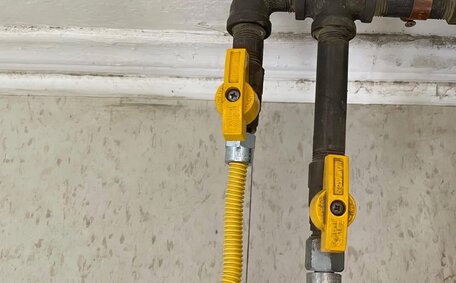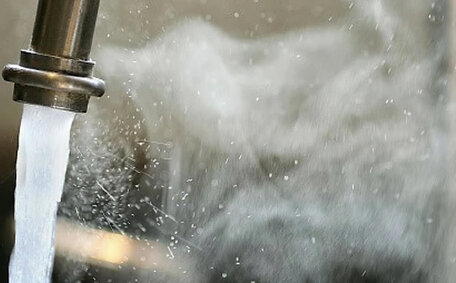Introducing Direct and Indirect Water Heating Systems
Two predominant home water heating systems exist: direct and indirect. Each plays a crucial role in providing hot water for cooking, cleaning, and personal hygiene.
Direct water heaters heat water directly within the unit before it is supplied to your household. The hot water heater facilitates contact with the heat source, which can include gas, electric, solar energy, etc. Examples of direct systems are those where water heaters use an immediate method for heating the water.
Indirect water heaters transfer heat from an external source like a boiler or furnace to your household’s water system. An indirect water heater circulates water through a heat exchanger, connecting it to an external heat source like a boiler.
In an indirect domestic hot water system (DHW), water is heated indirectly, a distinctive feature of these models. Some examples include the tankless coil water heater system and indirect tank models.
While both types supply heated water, there are specific pros and cons indirect systems have, differentiating in factors like efficiency, cost, maintenance, and suitability. A clear grasp of the workings of hot water systems is pivotal for homeowners to choose the most suitable option for their needs.
Upfront Cost Comparison
Assessing your hot water usage patterns is essential to comprehend the cost variances between direct and indirect water heating systems. Here is an overview of the initial investment required:
Direct Water Heaters
- Storage tank systems - $500 to $1000 for electric, $1000 to $1500 for gas
- Tankless systems - $1000 to $2000 for electric hot models, $2000 to $3500 for gas types
Indirect Water Heaters
- Add $1000 to $2000 to your indirect boiler/furnace system cost
- Tankless coil system - $1500 to $2500 installed
- Indirect tank system - $2000 to $4000 installed
Installation expenses can additionally range from $200 to $1000 on top of the price of the equipment. Variables like system size, energy source, complexity, labour, and location impact overall pricing.
Solar hot water systems can cost between $4000 to $10000 initially but may qualify for renewable energy rebates.
| System Type | Typical Cost |
| Electric storage tank | $500 - $1000 |
| Gas storage tank | $1000 - $1500 |
| Electric tankless | $1000 - $2000 |
| Gas tankless | $2000 - $3500 |
| Add-on indirect system | $1000 - $2000 |
| Tankless coil system | $1500 - $2500 |
| Indirect tank system | $2000 - $4000 |
| Solar with rebates | $3000 - $9000 |
Operating Costs: Direct vs Indirect Water Heaters
Regarding operating costs and hot water output, indirect heaters generally prove to be more efficient and cost-effective than direct heaters.
Indirect systems effectively use the primary boiler or furnace to heat your space, often more energy-efficient than separate water heating solutions. This synergy of heating space and water concurrently positions indirect systems as an optimal choice.
Here’s a look at the factors that contribute to operating costs:
Energy Use
Direct heaters generate the required heat, sometimes through an open flame, to instantly heat water on demand. Tankless direct heaters use gas or electric sources, consuming 4-6 kW of electricity or, if using natural gas, between 199,000-300,000 BTU/hour.
While active systems can be efficient, indirect systems enhance this efficiency by leveraging the home’s boiler to save on energy. This can ensure your home enjoys the warmth of efficiently produced warm air, translating to lower monthly energy bills.
Efficiency
Modern direct tankless units, if maintained well, can achieve efficiencies from 0.82 to 0.98, minimising heat loss. Older tank-style direct heaters show lesser efficiency, between 0.50-0.75, often due to wear tear over time.
Indirect water heaters, when paired with the home’s heating system, can attain efficiencies ranging from 0.83 to 0.93. Their reliance on the primary heating system improves efficiency.
Monthly Costs
A family of four may incur monthly running costs around $40-$60 for direct heaters, opposed to $30-$50 for indirect systems, courtesy of lower fuel or electricity use.
Installing an on-demand recirculation pump with your water heater can save up to $15 per month on water heating bills.
Energy Efficiency and Environmental Impact
Energy efficiency comparisons reveal that indirect water heaters typically outperform direct systems. This is because they leverage the home’s existing heating system rather than generating all the heat themselves.
Standard direct tankless heaters have energy ratings around 0.82 to 0.98 EF (energy factor). Older direct storage tank models range from 0.50 to 0.75 EF. On the other hand, indirect fired water heaters can achieve 0.83 to 0.93 EF ratings by utilising the primary boiler or furnace for heating.
In terms of environmental impact, gas-fired direct heaters produce carbon emissions from burning natural gas or propane. The exact amount depends on the heater’s efficiency rating. Indirect systems paired with high-efficiency gas boilers or renewable energy like solar thermal tend to have a lower carbon footprint.
Solar water heating systems with an indirect heater have no emissions at the point of use and help reduce dependence on traditional power sources. Solar direct systems are the most environmentally friendly but involve high upfront costs.
Direct systems with heat pumps are adept at using electricity efficiently, thereby contributing to a reduced carbon footprint. Nonetheless, their effectiveness hinges on local climate conditions. Indirect systems often provide more flexibility to employ environmentally friendly heating sources, reducing greenhouse gas emissions.
On the other hand, indirect fired water heaters can achieve 0.rods need to be inspected and replaced every 2-5 years to protect the tank water heater from corrosion. Sediment buildup also needs to be flushed out periodically.
Tankless direct heaters require annual inspections to check for hard water scale buildup which can block internal components. Descaling may be needed to restore performance.
Indirect systems, when connected to your boiler, feature fewer parts exposed to hot water, such as the heating coil. Maintenance is limited to inspecting the heat exchanger coils and circulation pump annually.
The cons indirect water heater systems have are few, with one of the advantages being that they avoid corrosion issues as the water is heated externally. The closed heating loop prevents oxygen contact which causes corrosion in direct systems.
The capacity of a water heater affects how much hot water it can supply to meet household demand. Storage tank heaters have a fixed capacity ranging from 20 to 80 gallons. Once depleted, you must wait for the tank to reheat more water.
Tankless systems heat water on demand so their capacity is limited only by the size of water pipes and flow rate. Endless hot water is possible but performance may drop at peak usage times.
Households with sporadic high hot water demand may benefit from opting for a tankless system. Though storage tanks recover faster, capacity is limited and may result in cold water if depleted.
For families with more consistent hot water needs, a properly sized storage tank is a better choice. Though slower to recover, it holds sufficient capacity for typical daily usage.
Installing large-capacity commercial tankless heaters can accommodate most households but involves higher upfront costs. An indirect tankless coil system also combines endless hot water with storage capabilities when demand exceeds coil heating rates.
Households with sporadic high hot water demand may benefit from opting slower to recover, it holds sufficient capacity for typical daily usage.
Choosing Between Tankless and Storage Water Heaters
When choosing between a tankless or storage water heater, there are a few key factors to consider:
gs
Cons:
- Higher upfront costs
- May need large-capacity model for peak demands
- Needs minimum flow rate to activate
Storage Water HeatersStandby heat losses from stored water
Fixed capacity limits hot water availabilityThose with limited space and occasional peak demand may prefer a tankless model. For consisty factors in choosing between the two. Consult with a plumbing professional to assess your needs.
Considering Your Home’s Size and Hot Water Needs
Evaluating Home Size and Hot Water Requirements
When selecting a water heating system, it’s crucial to consider your household’s size and daily hot water requirements. Tankless heaters can use a heavy-duty commercial model to serve larger households adequately. When selecting a water heating system, it’s crucial to consider your household’s size and daily hot water requirements. Take into account times of peak use like mornings when everyone is showering.
Larger homes with multiple bathrooms will have greater simultaneous demand and need a system that can supply adequate hot water pressure to every hot water tap at once. Discuss your specific needs with a professional plumber who can assess your water pressure, piping, and help determine the right system size to match both your home’s demands and budget.
Installation Factors
Proper sizing, connection to services, adequate space, and safety installations such as overflow/pressure relief valves are pivotal for installing water heaters. When installing water heating systems, several key factors should be considered. They also need proper sizing and connection to gas lines or electrical systems. Direct heaters like tankless water heater units require adequate space for installation, generally around 22-24 inches clearance.
For both types, venting systems are also used, as tank heaters need vents for combustion gases while tankless heaters require intake/exhaust vents. Installation professionals can also ascertain if system upgrades are necessary to accommodate the heater.
Lifespan and Durability Comparison
Indirect water heaters typically boast a longer lifespan and durability than direct heaters, implying potential long-term cost savings.
- Indirect systems have fewer components submerged in water so they experience less internal corrosion and mineral buildup over time.
- The closed heating loop of indirect units isolates components from oxygen exposure leading to reduced corrosion.
- Indirect heat exchangers and storage tanks are typically made of durable materials like copper, bronze, or stainless steel, ensuring they last much longer.
- The boiler or furnace component of an indirect system may need occasional maintenance or replacement, but the system itself can remain operable for 20 years or longer.
- A direct tankless heater can last 10-15 years on average. Storage tanks last 6-12 years before corrosion and leaks occur.
- Frequent maintenance and water treatment is needed for direct systems to maintain lifespans that can last longer than 15-20 years.
Properly installed and maintained, indirect systems can surpass 20 years of operation, while direct systems average 10-15 years, with tank models at a lower range. Proper maintenance is crucial for extending the lifespan of any water heating system.
The Bottom Line: Which System is Right for You?
When deciding between a direct or indirect water heating system, consider your budget, usage needs, available space, and long-term operating costs. Indirect systems have higher upfront costs but can get greater energy efficiency and lower monthly bills in the long run.
Tankless heaters offer endless hot water but may be undersized for large households.
Contact us today for a free consultation to determine the most efficient and high-performance water heating system offering lasting value for your home.






